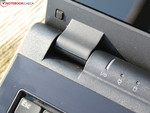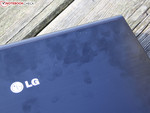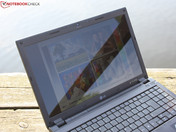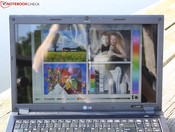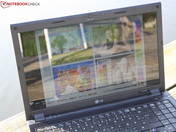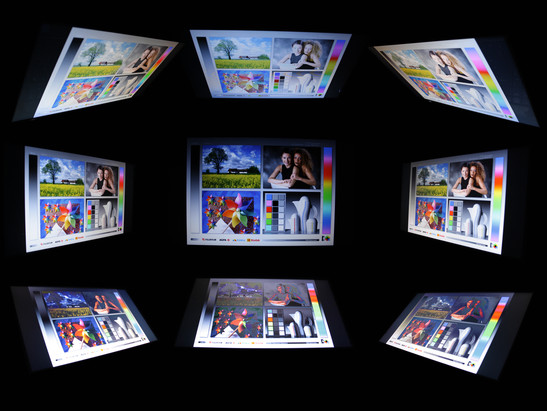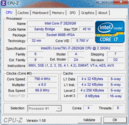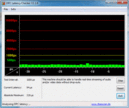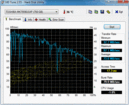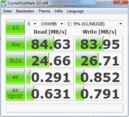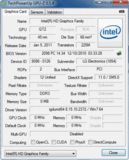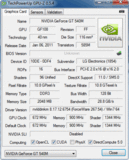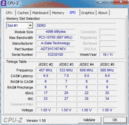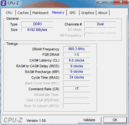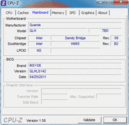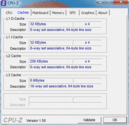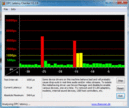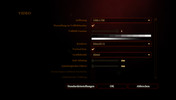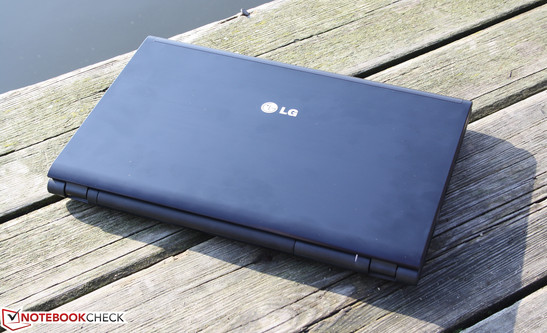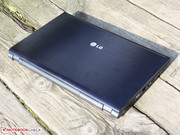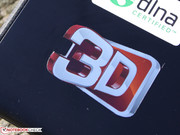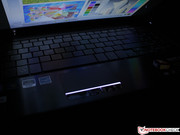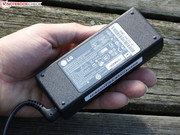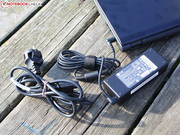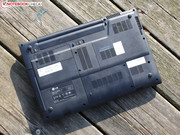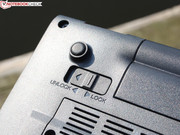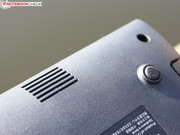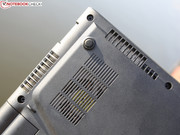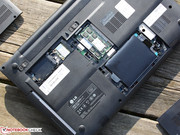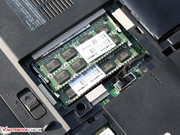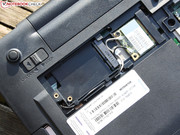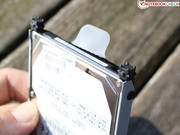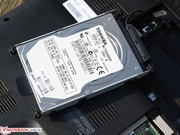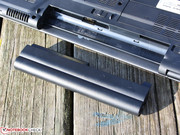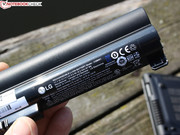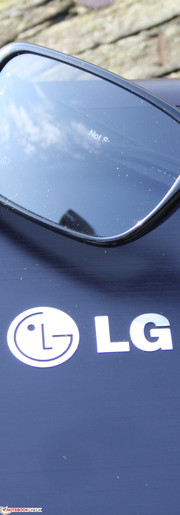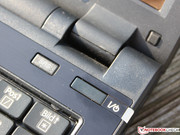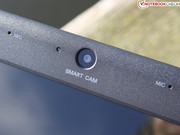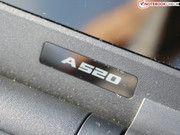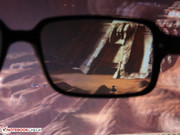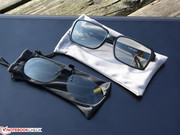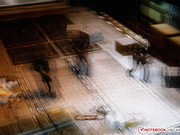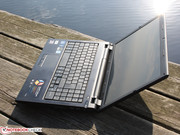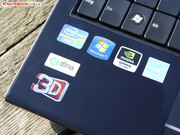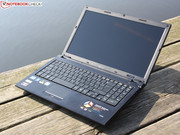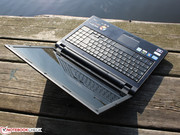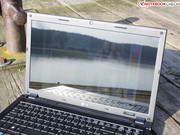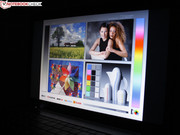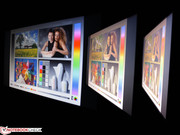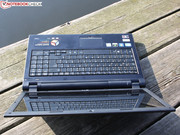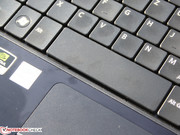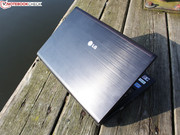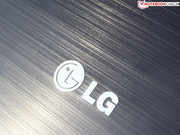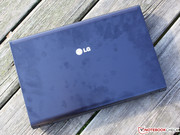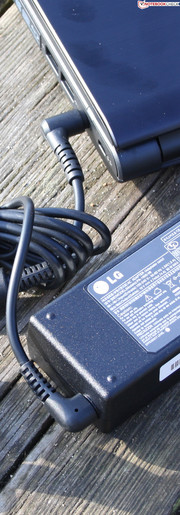Review LG A520-T.AE31G (3D/2820QM) Notebook

Almost two years have passed since Acer failed to bring its Aspire 5738DG 3D notebook to the buyers' attention. Hardly anyone wanted the 15.6 inch weak gamer (Radeon HD 4570). It could only conjure a gloomy and quite limited 3D effect with the polarized eyeglasses. Additionally, the GPU calculated the fields and caused the frames to cave-in by 50% during gaming.
The manufacturers quickly discarded polarizers and Nvidia's 3D Vision with active shutter glasses became standard among 3D laptops (usually 120 Hz screens). Even Acer had a 3D Vision notebook at the beginning of October 2010 called Aspire 5745DG and showed that TriDef 3D (polarizer technology software) was obsolete.
Now an LG Electronics A520-T.31G faces us that relies just on this polarizer technology from 2009. Back to the past? Is the Film Patterned Retarder (FPR) screen better than Acer's technology from back then? All information about 3D effects and the multimedia laptop can be found in our detailed review.
Case
LG's 15.6-inch model is in a case made of plastic and brushed, painted aluminum. The lid's black surface and the wrist rest usually have a cool touch, depending on the operating mode. They are also pressure resistant. We can even only depress the lid lightly over the surface. The qualitative aluminum surfaces however have a problem: Fingerprints stick to them like glue. Not all fingerprints disappear even after intense rubbing with a cleaning cloth.
The case is sufficiently rigid, but can be warped a bit with applied force. The bottom has a few maintenance covers that clearly yield. The display hinge is mounted tightly to the case and lets the lid hardly teeter. Although the screen is kept firmly in place, we only need one hand to open the notebook due to the base unit's high weight.
Connectivity
LG's 15.6 incher is meagerly equipped with connections. Conventional interfaces, such as eSATA and ExpressCard34 aren't installed. That will hit demanding users hard since they can't use their external eSATA hard disks any more. Retrofitting a controller isn't possible (via ExpressCard). Not even the old standard, FireWire, is on board to transfer movies from the camcorder. We ask ourselves, in face of this inadequacy, why a Cyberlink BluRay Disc Suite 7 is included when the interfaces for recording equipment are suboptimal.
The arrangement of the ports is also unfavorable. The front-heavy placement of the left ports could obstruct placing a mouse or at least look unsightly. It wouldn't have been wrong to banish unwieldy VGA, HDMI and Ethernet cables to the rear. Regrettably, this luxury is only available in very few laptops, especially in business devices.
Communication
The wireless draft n standard card (b/g/n) supports WLAN in its fastest generation. The Bluetooth module incorporated in the WLAN card supports the standard 3.0+HS. The Atheros LAN adapter communicates fittingly in Gigabit manner.
Supplies
A polarizing filter in the form of eyeglasses is needed to mix the two 3D field images. There is an attachment for persons who wear glasses. If you'd like to watch a 3D movie on the screen with friends, you can simply buy another pair of these affordable eyeglasses for about 15 euros (Philips Easy 3D polarizer glasses).
Why an A520 owner should remove the optical drive and replace it with the plastic cover - we don't know. A few grams can of course be saved this way, but the 50 grams from the BluRay drive doesn't matter at a weight of 2.55 kilograms. The cover is not a bezel for a hard disk!
Cyberlink's BluRay Disc Suite 7 is a consumer focused multi-tool for creating BluRay content. Too bad that it's not a burner, but only a BluRay reader (HL-DT-ST DVDRWBD CT30N). Thus, only the good old DVD-Rs can be burnt. At least the included Power DVD 9 player can play 3D BluRays.
There are no data carriers included, only instructions for quick start, recovery and 3D. The user has to create the recovery DVD (via LG Smart Recovery).
Warranty
LG grants a 24 month pick up & return warranty for the A520. Only six months is granted on the battery. The LG 3 year warranty extension costs about 65 euros and includes the same high-quality pick-up & return service.
3D with Passive Polarizing Filter
Coinciding with the debut of its first 3D TV for the mass market (LG LW 47 650 S) that works with passive polarized eyeglasses, LG now has a notebook based on the same principle in its range. The manufacturer apparently opposes the TV and notebook market because shutter technology (active eyeglasses) has firmly established itself in TVs and laptops in recent years.
Where is the advantage? The polarized eyeglasses work without electronics, don't flicker and only cost a few cents in production. LG includes 5 pairs in the boxes of its TV sets right away. The 3D picture is created by a foil on the screen, the Film Patterned Retarder (FPR). The screen's single lines are alternately polarized for the right and left eye. The glasses are also coated with a polarizing filter that shows the right eye the picture for the right and filters out the left picture. Photographers are familiar with polarizers, as they for example remove light effects on glass or lacquer.
According to LG, a perfect, fatigue-free view is supposed to be possible from every viewing angle. We are skeptical since laptop screens generally struggle with weak viewing angles. LG has however taken precautions and built in an LG Philips screen with a horizontal viewing angle of almost 90 degrees. Thus, deviations to the right or left are possible without losing the 3D effect. However, we also have to keep our heads fairly still vertically, so up or down, by LG.
When the 3D picture is created, the effect is impressive. But the brightness is reduced a bit, which can be compensated by turning up the brightness indoors. But 3D is unfortunately not always supported. The 3D fields of a movie, a picture or a game doesn't simply come from nowhere. It has to be calculated simultaneously. The software, TriDef Ignition, takes care of that. It already helped the Acer Aspire 5738DG enter the third dimension at the end of 2009. TriDef calculates the stereoscopic counterpart of existing fields of a movie or game. The graphics card processing unit stems the needed computing power. Pictures, movies and games have to be opened via the TriDef software.
DVD Movies
A 2D movie can only be made three dimensional with the TriDef player. The spatial effects in Lord of the Rings are impressive; the scenes look livelier. There aren't any problems with the simultaneous calculating of the stereo image, not even in fast action scenes. Important: The encoded material's quality determines the effect. The noisy vacation clips made with a compact camera won't inevitably be a pleasure. The effect's depth can be modified easily in the player via the control (default 50%).
BluRay Movies
Disappointed, we take our BluRay movie out of the drive. The TriDef player can't at all play the BluRay and the included Power DVD 9.0 player isn't compatible with TriDef. Now we can play our movie, but without 3D effects. The polarized filter screen can likely first be used with a genuine 3D BluRay. We couldn't try it because we didn't have 3D BluRay at hand. Too bad, because Nvidia Vision based 3D laptops, such as the Vaio F21, could convert our standard movie to 3D and play it via Power DVD without problems.
Pictures
The TriDef player can calculate good to very good 3D effects in a clearly separated foreground and background. Thus, the private picture collection isn't really suitable for that.
Games
Please see the section about 3D performance in TriDef for the performance assessments. The 3D effects in StarCraft 2 can impress us when it's compatible with TriDef. Deviating a bit to the right or left isn't a problem. But the eyes shouldn't sway up or down. As said, every game has to be opened via the TriDef Ignition player. This could be problematic with steam installations. Thus, RUSE refused to work. Dragon Age 2 could be started on TriDef, but we didn't see any 3D effects. We didn't have these problems with Nvidia Vision since 3D rendering is directly targeted on the Nvidia graphic card's driver and a vast amount of games are supported natively (e. g. Vaio VPC-F21Z1E/BI).
Input Devices
Keyboard
The keys provide the typist with a pressure point that is inclined to lack clarity and a soft key stroke. The key surface fits tight all over and doesn't coil anywhere. Even the area over the optical drive isn't affected by a yielding surface. It provides a satisfactory writing experience combined with the medium key drop.
The built-in number pad is beneficial for entering numbers. Unfortunately, it isn't a full-size number pad, but a stripped pad without minus, plus and enter on the outer right. This could annoy habitual prolific typists. The arrow keys are only half the size as the normal letter keys. Nevertheless, we can touch type very well because they have a small gap above them.
Touchpad
The mouse replacement is a Synaptics multi-touch pad (V7.2), so a technically outdated model (current: V7.5). It is nevertheless capable of multi-finger gestures, such as two finger zoom. The small pad's smooth surface can be used quickly and is sensitive up to its edges. The keys click quietly but have a too short key drop (snappy). The concise pressure point comes right after the touch, which overall makes the keys' feedback tolerable.
The pad has a horizontal and vertical scroll bar, even if they aren't marked. The scroll fields are no longer essential due to two finger recognition. Users can disable the scroll fields to increase the relatively small pad area.
Display
Our LG A520-T.AE31G 15.6 incher is equipped with a 16:9 screen. We are dealing with a Full HD, 1920x1080 (1080p) - a resolution that many gamers and computer workers would like to have. The glare-type display is read out as LP156WF2-TLA1 (LG-Phillips). The screen is vaporized with a special coating, Film Patterned Retarder (FPR), which is also used on LG's 3D TVs.
The FHD panel has a good contrast of 508:1. It ensures crisp, brilliant colors. On the other hand, the color spectrum (ICC profile) isn't as good. sRGB is clearly failed. The 3D competition, Asus G74S and Vaio F21Z1EB (both FHD, Nvidia 3D Vision), is superior to this screen in terms of reproducible colors.
| |||||||||||||||||||||||||
Brightness Distribution: 85 %
Center on Battery: 203 cd/m²
Contrast: 508:1 (Black: 0.4 cd/m²)
54.3% AdobeRGB 1998 (Argyll 3D)
71.4% sRGB (Argyll 3D)
56.9% Display P3 (Argyll 3D)
The screen distributes the brightness evenly over the display (85%). This means that the LED backlight's deviations are very minor (homogeneity). The minimum and maximum are only 31 cd/m2 apart. The brightness is nevertheless overall below average with 195 cd/m2, but suitable for indoor use.
If you go out in the sun and want to play a game of StarCraft 2 with the A520, you should look for a shady place to avoid reflections. Our pictures were taken in sunlight and maximum brightness. Since the 15.6 incher doesn't reduce its brightness in battery mode, the result is viable in certain viewing angles. However, reflections interfere in almost every position.
Such wide viewing angles as in the LG A520 regrettably hardly ever delight the eye. The contrast remains stable horizontally and there is no inverting (ghosting). The horizontal viewing angle is about 85 degrees. The screen can keep up with a desktop TFT. But that's not the case vertically, because we can see this infamous ghosting as of about 25 degrees (from below). This does not apply to looking down. Please see our viewing angle video.
Performance
The Sandy Bridge quad Core i7-2820QM with 4x2.3 GHz (default clock), isn't as omnipresent in consumer laptops as its "smaller" brother, i7-2630QM. But if the latter ensures a strong application performance, it can only get even faster with this high-end model. The CPU can be overclocked up to 3.4 GHz via Turbo Boost 2.0. You can read if the cooling system can deal with that in Temperature. Please see the data sheet for all CPU details.
The memory controller and the HD Graphics 3000 are incorporated into the quad core with a TDP (thermal design power) of 45 watts. The IGP ensures an energy saving operation when Nvidia's Optimus disables the GT 540M at times. The mass memory is a 750 GB Toshiba MK7559GSXP. Its slow rotation speed of 5400 rpm doesn't really fit into the picture of a high-end consumer. Will it slow the system down? The answer is given by Windows 7 Performance Index.
The Cinebench 11.5 CPU test (Multi, 64-bit) doesn't fare quite as well as hoped with 4.88 points. The often used 2630QM even reaches an average of 4.7 to 5.0 points, for example, in the Acer Aspire 7750G. The workstation, Lenovo ThinkPad W520 and the gamer, Alienware M17x R3 show the 2820QM the way: 5.6 respectively 5.5 points. The cooling system is apparently not able to cool the processor sufficiently enough so that the clock rate is kept well above 2.3 GHz (default clock) for a longer period. More about that in Temperature.
However, the results vary. Our A520's CPU benchmarks aren't all poorer than other devices with the same processor. The 338 seconds determined by the CPU benchmark, wPrime are better than the Alienware M17x R3's 382s, but worse than the Lenovo ThinkPad W520's 281s. The recently reviewed workstation, Fujitsu Celsius H710 WXP11DE, even needed 485s for the test - a rate that even the old 740QM can undermine.
PCMark Vantage determined strong 8987 points. A remarkable figure that even the power gamer, Alienware M17x R3 (GTX 580M, HDD) can only beat slightly (9453 points). The Lenovo ThinkPad W520, which is better at CPU benchmarks, scores even lower with 8614 points. Apparently, the weaknesses in single CPU benchmarks have no impact on overall performance.
We executed PCMark 7 which finishes with 2376 points. The Alienware M17x R3 has a clear lead here. Likely due to the better assessment of the GTX 580M's pure GPU performance. This test was unfortunately still unknown to the Lenovo ThinkPad W520. But not so to the Fujitsu Celsius H710 that scored 3695 points. The latter points impressively show how a device equipped with an SSD easily manages to accomplish a very good system performance, despite its below average CPU performance for its category. The A520 could belong to the top group in application performance with a fast SSD.
| PCMark Vantage Result | 8987 points | |
| PCMark 7 Score | 2376 points | |
Help | ||
The GeForce GT 540M (2048 MB, DDR3) belongs to Nvidia's midrange. The Fermi chip supports DirectX 11. The memory is clocked at 672/900 MHz (core / memory), as in most test devices. 3DMark2006 (1280x1024) finishes with 8162 points. A Radeon HD 6850M (~9700) can even top that with the same memory unit. When we start 3DMark06 via TriDef, the score is halved to 4180 / 3108 (total / CPU).
The 3DMark Vantage score (P4450) is on the level that a GT 540M should have when accompanied by a strong CPU. The new GT 555M is even clearly stronger with 5469 points. 3DMark 11 achieves 1009 performance points. The HD 6550M (P1107) and even the older HD 5650 (P1024) look better here.
| 3DMark 05 Standard | 15732 points | |
| 3DMark 06 Standard Score | 8162 points | |
| 3DMark Vantage P Result | 4450 points | |
| 3DMark 11 Performance | 1009 points | |
Help | ||
Too bad that LG doesn't use an SSD. But their small memory capacity would certainly have deterred many multimedia fans. Together with the extremely powerful quad CPU, PCMark Vantage's HDD score wouldn't have been a downright ridiculous 3751 points, but 15000 - 20000 instead. This could have increased the above mentioned system scores of PCMark Vantage and PCMark 7 considerably. See the Fujitsu Celsius H710 (16628 / 3695 points).
HDTune (73 MB/s read) and Crystal Disk Mark 3.0 (84 MB/s read) report that this Toshiba HDD (750 GB, MK7559GSXP) doesn't have bad, but typical throughputs for a 5400 rpm disk. The rates could be slightly higher with a 7200 rpm HDD, but the difference would be insignificant.
We have already looked at the GT 540M midrange GPU's gaming performance in detail. The data sheet shows all games. Our test device's strong processor could tend to provide a slight frame rate improvement. However, potential buyers shouldn't expect a very big leap. We make a random test with StarCraft 2 and Dirt 3 for our test database. RUSE and Dragon Age 2 are not included in the database. All mentioned scores have been made without 3D mode.
Star Craft 2
The real-time strategy game caves in to 29 (medium, otherwise 45) and 17 (high, otherwise 32 fps) in 3D mode (TriDef natively supports the game). That is just a bit less the often mentioned performance 50% decrease of a 3D laptop.
| StarCraft 2 | |||
| Resolution | Settings | Value | |
| 1360x768 | high | 32.5 fps | |
| 1360x768 | medium | 45 fps | |
Dirt 3
The race game's result can be repeated exactly with the built-in benchmark. We naturally tried out the FHD resolution, but have to deny it playability due to 13 fps. But then, it runs very well in high details and 1366x768 pixels: 39 fps. The powerful quad CPU has little impact on higher fps. The Toshiba Satellite P770-10P, with a GT 540M (2048 MB, same clock 672/900 MHz, i7-2630QM) runs with 38 fps in high. Even a MSI GE620 (i5-2410M) provided 38 fps.
| Dirt 3 | |||
| Resolution | Settings | Value | |
| 1920x1080 | Ultra Preset, 4xAA, -AF | 12.7 fps | |
| 1360x768 | High Preset, 2xAA, -AF | 39 fps | |
| 1024x768 | Medium Preset, 0xAA, -AF | 61 fps | |
| 800x600 | Ultra Low Preset, 0xAA, -AF | 138 fps | |
RUSE
RUSE will entertain real-time strategy games' fans - but not in FHD and highest details (Ultra settings). The demo's mission takes place in the first 5 minutes with an average of 9 fps. Since a frame rate beyond 30 fps isn't needed for this kind of game, high details in 1366x768 (4AA) are well playable. 22 fps. We accomplish better 32.5 fps in medium details, again in 1366x768 pixels and reduced antialiasing 2(AA).
Dragon Age 2
The battle game with a thin story craves for strong hardware. This isn't the case with this GPU and thus only 19 fps are possible even in 1366x768 and high details (2AA, DX11). It's first perfectly smooth in medium details (0AA, DX11) and the same resolution (0AA, DX11): 38 fps.
Gaming Verdict
Too bad: LG A520's good FHD screen would have been perfect for gamers. But the frame rates cave in every time the highest resolution is selected and current games become unplayable. The generous DDR3 memory configuration of 2048 isn't of much use here, either. A GDDR5 would have been necessary.
If you aren't as demanding, you'll experience a feasible gaming performance on the Geforce GT 540M. Only 3D mode isn't always possible, though. Either because the game doesn't support TriDef (RUSE, Dragon Age 2) or because the frame rate is almost halved (StarCraft 2, native support). A GT 555M would have been the better choice for the 3D LG.
| low | med. | high | ultra | |
|---|---|---|---|---|
| StarCraft 2 (2010) | 45 | 32.5 | ||
| Dirt 3 (2011) | 138 | 61 | 39 | 12.7 |
Emissions
System Noise
Relaxed typing in Word without being bothered by a loud fan. LG solves the quad core laptop's waste heat issue quite well. The noise level doesn't exceed 39 dB (A) during normal load, such as a game or 3DMark06. You'll sometimes not even hear the fan when you only surf on the Internet or type in Word with 32 dB (A). It however is never turned off. The Toshiba HDD is only audible by a quiet clacking when reading or writing (32 dB (A)).
The stress test, where processor and graphics card work to capacity, tickles out the maximum 42 dB (A). The fan blows hot air out of the case. At least the noise stays constant. The fan only needs about 25 seconds to drop to the very quiet level of 32 dB (A) when the load is finished.
Noise level
| Idle |
| 31.9 / 31.9 / 31.9 dB(A) |
| HDD |
| 32.3 dB(A) |
| DVD |
| 35.1 / dB(A) |
| Load |
| 39 / 41.9 dB(A) |
 | ||
30 dB silent 40 dB(A) audible 50 dB(A) loud |
||
min: | ||
Temperature
The permanently turning fan ensures a cool case in idle. Its top stays under 30 degrees. The temperatures increase under load, but never exceed 45 degrees. The low waste heat with this powerful CPU configuration has a reason:
Throttling @GPU load
The CPU's clock quickly throttles to 1.4 to 1.6 GHz (default clock 2.3 GHz) during the multi-hour stress test (Prime95+Furmark). The system's power consumption: 84 watts. Every time we paused Furmark (GPU load), the clock increased to 2.3 to 2.9 GHz (depending on the duration of load) and the power consumption stably remained at 81 watts. Core Temp always indicated 25 degrees Celsius to Tjunction during the stress test (Prime95+Furmark). Conclusion: It's not a temperature limit that throttles the CPU. The too weak, 90 watt power adapter has fault. If the CPU+system already need 81 watts during load, where are the additional 25 to 30 watts to be taken that the GT 540M needs in load?
But: If you don't permanently work at the power zenith, you'll hardly notice throttling. Most CPU (except Cinebench R11.5) and all 3D benchmarks (incl. games delivered a hardware typical performance. As we noted, the cooling system can cool the hardware and even keep Turbo Boost 2.0 upright (see second screenshot). Throttling only takes place when the CPU is loaded to 100% and a very high GPU load is executed at the same time, which would cause the power consumption to climb a lot higher than 90 watts. The 90 watt adapter doesn't allow the latter, though.
(±) The maximum temperature on the upper side is 43.2 °C / 110 F, compared to the average of 36.9 °C / 98 F, ranging from 21.1 to 71 °C for the class Multimedia.
(±) The bottom heats up to a maximum of 42.2 °C / 108 F, compared to the average of 39.2 °C / 103 F
(+) In idle usage, the average temperature for the upper side is 27.2 °C / 81 F, compared to the device average of 31.3 °C / 88 F.
(+) The palmrests and touchpad are reaching skin temperature as a maximum (33.2 °C / 91.8 F) and are therefore not hot.
(-) The average temperature of the palmrest area of similar devices was 28.7 °C / 83.7 F (-4.5 °C / -8.1 F).
Speakers
The 15.6 incher is equipped with stereo speakers located underneath the wrist rest. The sound emphasizes the midranges and trebles (balanced, clear), but low ranges are non-existent. The SRS sound enhancement that can be enabled by a button doesn't help here at all. The improvement is nearly nada. We don't understand why the A520's sound is heralded as SRS Wide 3D. The effect only works when speakers or headphones are connected.
Battery Life
The viable idle and WLAN runtimes (mix of Internet, video load and idle) let us assume that our A520 only needs little power in these operating modes. Our multimeter confirms this: The lowest power consumption in idle ranges from 17 to 21 watts. We measured the lowest and the highest power requirement in idle for this (without battery charging).
The stress test is the opposite (Prime95, Furmark) and is 84 watts. This power consumption isn't enough for the 45 watt quad CPU, 2820QM, and the GT 540, which we explained in CPU throttling in temperature. The reason is the weak 90 watt power adapter. The Fujitsu NH751, with a smaller quad CPU (2630QM) and a GT 525M graphics, is equipped with a 120 watt power adapter to begin with (no throttling). This would have at least been needed for the LG A520.
| Off / Standby | |
| Idle | |
| Load |
|
Key:
min: | |
The rather modest runtime, the low TFT brightness and the glare-type screen don't exactly encourage mobile use. The WLAN surfing test comes very close to the real battery life. The battery is drained after three hours. The LED screen ran with 100 cd/m2 during the test. Our BatteryEater's load test can depict if a game of StarCraft 2 is possible. The lights go out after only an hour. A 57 Wh lithium ion battery is responsible for the runtime (5200 mAh). It needs acceptable 2:13 hours to fully recharge.
Verdict
The manufacturer, LG, is back on the German notebook market and wants to show what the Koreans are capable of with its 3D flagship, A520, right away. Not only the manufacturer's TVs are delivered with cheap, because passive, polarized glasses as an accessory. A notebook model now does as well. A special foil on the screen and software (TriDef) that simultaneously calculates a second picture takes care of 3D effects.
However, the 3D picture doesn't awe the testers. The dependency on the horizontal viewing angle is minor, but we have to sit quite still. The contrast rich FHD screen equipped with wide horizontal viewing angles is a good basis with and without 3D. Nevertheless, it doesn't achieve such a good (no dimming) and variable picture (head position) as the Vaio VPC-F21Z1E/BI 3D notebook (very good screen) provides.
As usual, the gaming performance suffers due to active 3D effects (-50%). Because the second image has to be calculated by the graphics card no matter if polarizing filters or active shutter glasses. This isn't a problem with DVD movies at all. However, current games cave-in hopelessly in terms of frame rates. If you are interested in 3D gaming, you should stick to a considerably stronger graphics card. But many of our 3D test devices, such as the Asus G51J, Asus G53JW, Acer Aspire 5745DG or Asus G74SX-3DE (all Nvidia Vision), have vanished from the online shops. In particular the latter would be the perfect partner for smooth 3D gaming with its strong GTX 560M. Another device with very good 3D effects would also be the Vaio VPC-F21Z1E/BI.
The fairly stable laptop construction with the feasible, though not perfect input devices regrettably attracts fingerprints magically. However, the user could ignore this if he takes delight in the very good performance of his quad core system. This is even true for games (in medium settings) excluding 3D effects, which can supply a lot of entertainment with the contrast rich screen. The undersized 90 watt adapter puts a damper on fun. The CPU clock throttling (@ maximum load GPU+CPU) could easily be solved with a 120 watt power adapter.
A manageable power consumption (idle), a low noise (incl. Silent Mode and low waste heat (also due to throttling) is accomplished despite the high performance. Unfortunately, LG has left out contemporary interfaces, such as USB 3.0 and / or eSATA. These controllers can't be retrofitted either due to the lack of ExpressCard.
If you don't need the 3D effects, you'll find equally strong configurations for less money in retail. The 2820QM processor isn't available for a lower price, but consumers won't do much worse with a 2630QM, either. For example, the Acer Aspire 5750G, MSI GE620-i748W7P or Asus X5MSV-SX319V with the GT 540M are available for around 700 euros. All these devices don't have such a good FHD screen, but at least USB 3.0.




